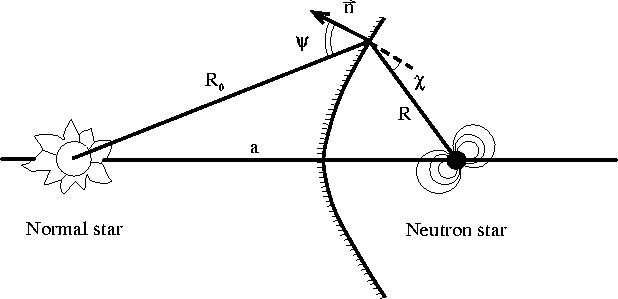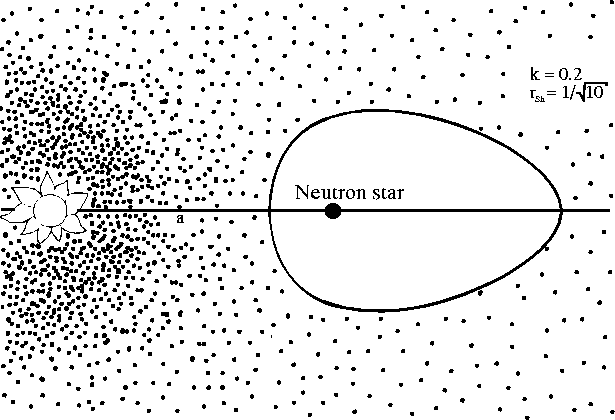Next: The Effect of Relativistic Up: Ejectors in Massive Binary Previous: Why do Radiopulsars not
![]()
![]()
![]()
![]()
![]()
Next: The
Effect of Relativistic Up: Ejectors
in Massive Binary Previous: Why
do Radiopulsars not
We follow the approach used by Lipunov and Prokhorov (1984)[110].
Suppose that a NS having a rotational magnetic luminosity
![]() forms a binary system (with semi-major axis a)
with a normal star losing matter in the form of stellar wind (with a loss
rate
forms a binary system (with semi-major axis a)
with a normal star losing matter in the form of stellar wind (with a loss
rate ![]() ).
).
Let us find the Schwartzman radius in accordance
with the definition and by equating the plasma pressure ![]() to the electromagnetic pressure
to the electromagnetic pressure ![]() :
:
![]()
where R is the distance from the NS. The Schwartzman radius is (see Lipunov and Prokhorov, 1984[110]; Harding, 1991[64]):

When making estimates, it is convenient to use the fact that the outflow rate, luminosity and the stellar wind velocity of hot stars are connected through the empirical relation (see, for example, Barlow and Cohen, 1977[8])
![]()
where ![]() -0.4. This leads to the approximation
-0.4. This leads to the approximation
The luminosity of normal stars whose mass varies from a few times to
several tens of times the mass of the Sun lies in the interval between
![]() and
and ![]() -
- ![]() erg s
erg s![]() . The rotational magnetic luminosity of NS also varies
in the same wide range. For ``aged'' radiopulsars,
. The rotational magnetic luminosity of NS also varies
in the same wide range. For ``aged'' radiopulsars, ![]() erg s
erg s![]() , while for young pulsars
, while for young pulsars ![]() may be as high as
may be as high as ![]() -
- ![]() erg s
erg s![]() . Equation (10.4.3) shows that entirely
different situations may arise in different binary systems at various stages
of evolution. For example,
. Equation (10.4.3) shows that entirely
different situations may arise in different binary systems at various stages
of evolution. For example, ![]() or
or ![]() . This means that while deriving the formula for a cavern in the general
case, we must take into account the proximity of the normal star.
. This means that while deriving the formula for a cavern in the general
case, we must take into account the proximity of the normal star.

Figure 28: Schematic representation of a pulsar in a pair with a
normal star.
Let us calculate the shape of a cavern surrounding
a NS, assuming that the relativistic wind ejected by the star is spherically
symmetric. We also assume that ![]() . At the cavern boundary (Figure 28), the
following equilibrium condition must be satisfied:
. At the cavern boundary (Figure 28), the
following equilibrium condition must be satisfied:
where ![]() is the distance from the normal star, V is
the volume of the cavern, and
is the distance from the normal star, V is
the volume of the cavern, and ![]() is the gas pressure. The second term on the right-hand side of the equilibrium
equation (10.4.4) corresponds to the contribution
of the pressure of the magnetic dipole radiation which is reflected back
by the cavern ``walls'' and is accumulated inside it. The factor
is the gas pressure. The second term on the right-hand side of the equilibrium
equation (10.4.4) corresponds to the contribution
of the pressure of the magnetic dipole radiation which is reflected back
by the cavern ``walls'' and is accumulated inside it. The factor ![]() is zero for an open cavern and approximately 1 for a closed cavern. The
static gas pressure
is zero for an open cavern and approximately 1 for a closed cavern. The
static gas pressure ![]() can be presented in the form
can be presented in the form
![]()
For an isothermal stellar wind (as a rule, this is the situation commonly encountered), n=0. We use dimensionless variables:

In this case, equation (10.4.4) becomes
![]()
Let us consider the case of an isothermal stellar wind (n=0)
with no magnetic dipole radiation accumulated (![]() ):
):
![]()
It follows from the symmetry considerations that at the anterior point
of the cavern (i.e. the point closest to the normal star), ![]() . This leads to the following expression for the distance from the anterior
point:
. This leads to the following expression for the distance from the anterior
point:
![]()
Similarly, we can determine the distance ![]() from the posterior point of the cavern. We get
from the posterior point of the cavern. We get

If ![]() , the cavern is closed. The value of k is of the order of the ratio
of the square of the velocity of sound to the outflow rate of the stellar
wind, so that in real situations
, the cavern is closed. The value of k is of the order of the ratio
of the square of the velocity of sound to the outflow rate of the stellar
wind, so that in real situations ![]() -
- ![]() . Hence closed caverns must be quite compact:
. Hence closed caverns must be quite compact: ![]() -
- ![]() . In most cases, the assumption k=0
may serve as a good approximation.
. In most cases, the assumption k=0
may serve as a good approximation.
Only the electromagnetic waves with a frequency higher than the plasma
frequency ( ![]()
![]()
![]() Hz) may propagate in a plasma. The characteristic density in the stellar
wind is estimated from the continuity condition
Hz) may propagate in a plasma. The characteristic density in the stellar
wind is estimated from the continuity condition
![]()
where ![]() . Thus, the magnetic dipole radiation should be reflected
from the walls. Suppose that the reflection coefficient
. Thus, the magnetic dipole radiation should be reflected
from the walls. Suppose that the reflection coefficient ![]() . In this case, the above analysis will remain valid if we redefine the
Schwartzman radius as
. In this case, the above analysis will remain valid if we redefine the
Schwartzman radius as
![]()
This gives
![]()
It can be seen that the size of the cavern has increased. As ![]() , the cavern cannot remain stationary. It is either always open or pulsating
quasi-periodically. In the latter case, the closed cavern expands right
up to the maximum value
, the cavern cannot remain stationary. It is either always open or pulsating
quasi-periodically. In the latter case, the closed cavern expands right
up to the maximum value ![]() :
:
![]()
The shape of the closed cavern is shown in Figure 29.

Figure 29: The cavern around a pulsar in a binary system (Lipunov
and Prokhorov, 1984).[110]